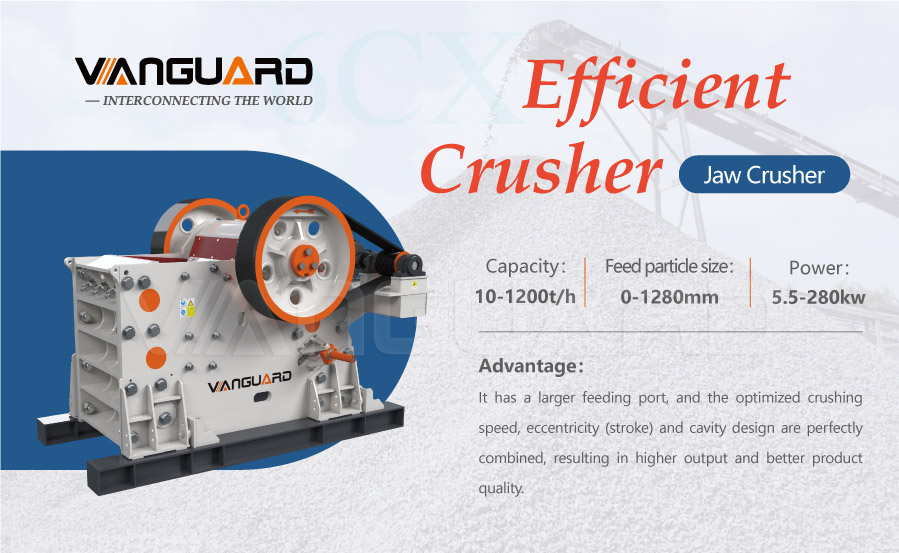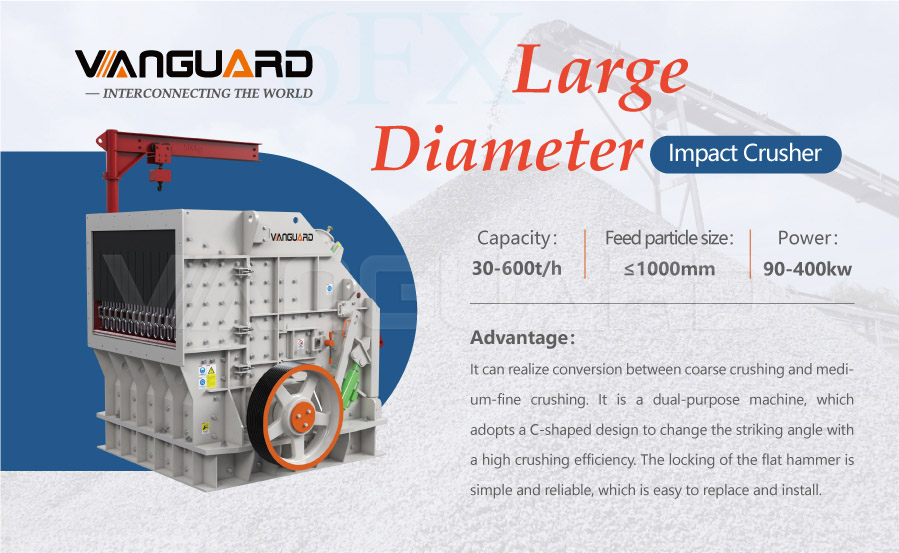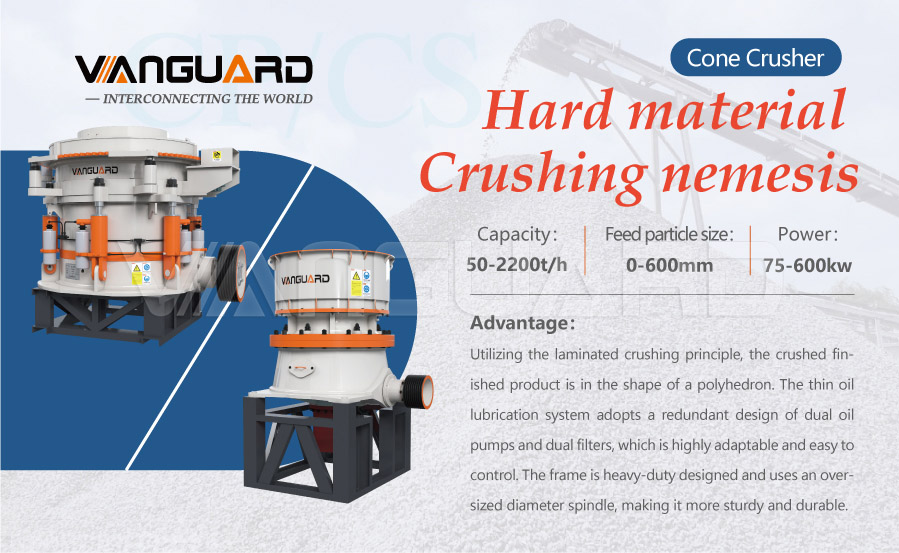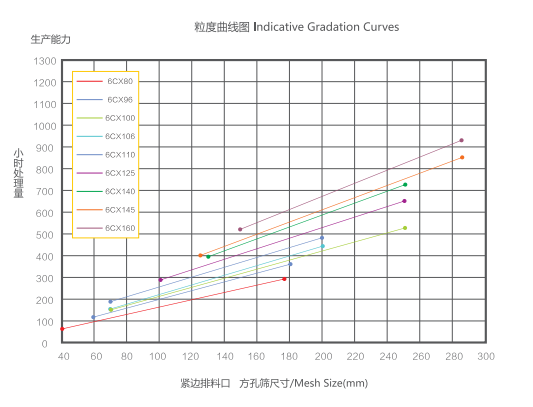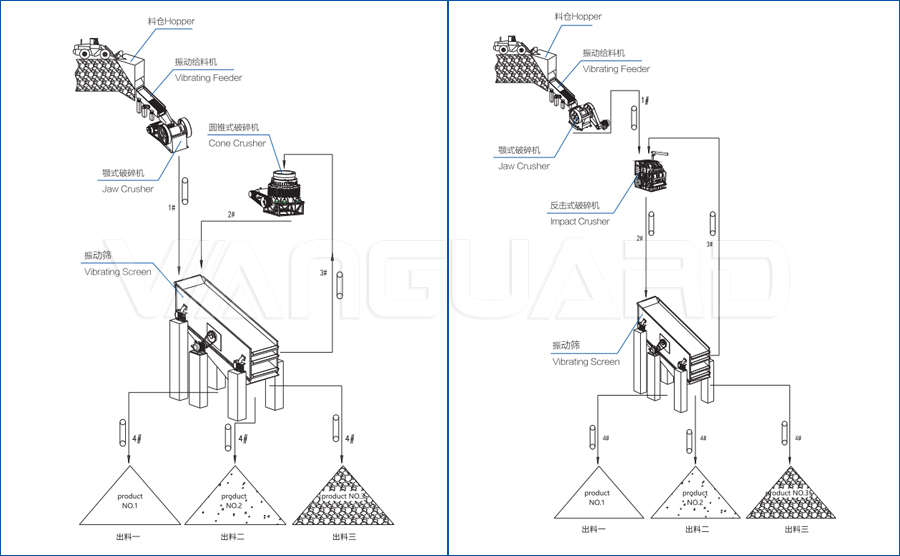Master the Particle Size Distribution Characteristics and Influencing Factors of Ore Crusher Equipment to Achieve Precise Control of Production Particle size
Date:2023-12-07Ore crusher equipment is a piece of indispensable equipment in the mining production process, and its performance and efficiency have an important impact on the entire mining production. Among them, particle size distribution characteristics are one of the important indicators for evaluating the performance of ore crushers. It directly reflects the particle size and distribution of ore after crushing. To achieve efficient and stable mining production, it is necessary to have an in-depth understanding of the particle size distribution characteristics and influencing factors of ore crusher equipment to achieve precise control of product particle size and improve production efficiency.
Particle size distribution characteristics refer to the size distribution of material particles. The finished particle size distribution characteristics of ore crusher equipment mainly include the uniformity of particle size distribution, particle size range and stability of particle size distribution. By analyzing these particle size distribution characteristics, we can understand the crushing effect of the crusher and the particle size distribution of the output materials, thereby guiding the optimization and adjustment of the operating parameters of the crusher to meet specific product requirements and process needs.
The factors that affect the particle size distribution characteristics of ore crusher equipment mainly include the following aspects:
1. Physical properties of ore
(1). Hardness: The hardness of raw materials directly affects the crushing effect and particle distribution.
(2). Humidity: Humidity has an important impact on the bonding force between particles and the energy consumption of the crusher.
(3). Viscosity: Viscous raw materials are prone to particle accumulation, affecting the uniformity of particle distribution.
(4). Brittleness: Ore has different brittleness and may have different particle size distribution characteristics under the same crusher conditions.
(5). Particle shape: The shape and size of the material will also affect the crushing effect and particle size distribution.
(6). Chemical composition: The chemical composition of the ore will also affect its physical properties, thereby affecting the crushing effect and particle size distribution.
2. Type of crusher
Different types of crushers will produce different particle size distribution characteristics during the crushing process, which depends on their working principles and structural characteristics.
3. Equipment parameter adjustment
Including the setting of discharge port adjustment, eccentric distance, rotation speed and other parameters, as well as the selection and adjustment of the screen and other equipment supporting the crusher, all will have an impact on the particle size distribution of the product.
(1). Feed size:
The control of the feed size of the crusher will directly affect the range and uniformity of particle distribution of the final product. Generally speaking, a smaller feed size will produce finer particles of the final product, while a larger feed size will produce a coarser particle size of the final product.
Excessive feed size will increase the wear and failure rate of the crusher, and will also cause the discharge size to be too large, affecting the subsequent process flow. If the feed size is too small, the working efficiency of the crusher will decrease, and energy consumption and production costs will increase. Therefore, it is necessary to determine the appropriate feed size and discharge size based on factors such as the nature of the ore, production needs, and the model and specification of the crusher.
(2). Discharge port size:
Adjusting the size of the discharge port can control the discharge size of the crushed materials. Generally, a smaller discharge port size will produce finer particles of the final product, while a larger discharge port size will produce a coarser particle size of the final product. For example: Taking the 6CX series European type jaw crusher as an example, the larger the adjustment of the tight side discharge port of the same model, the discharge size will increase, and the processing capacity will also increase; Vice versa.
(3). Crushing cavity type:
Different types of crushing chambers (such as standard, medium, fine, etc.) also have an impact on the crushing effect and particle size distribution of the crusher. Generally speaking, crushing chambers of different shapes and sizes will produce finished particles of different sizes. For example: taking a single-cylinder hydraulic cone crusher as an example, the CS coarse crusher is adjusted to 19-64, and the CH fine crusher is adjusted to 6-51. Different crushing cavity types will result in different particle sizes of final products. The cumulative screening of final products with different particle sizes. The proportion of network traffic will also be different.
In practical applications, the appropriate crushing chamber type needs to be selected based on specific ore characteristics, production requirements and equipment capabilities. At the same time, it is also necessary to consider the stability of the equipment, energy consumption and other factors, and comprehensively weigh and select an appropriate crushing cavity design scheme.
(4). Speed control:
The rotational speed will affect the residence time of the materials in the crushing cavity, thereby affecting the particle size of the finished particles. Increasing the speed of the crusher can increase the movement speed of materials in the crushing cavity, thereby increasing the degree of material crushing. However, the increase in speed will lead to a reduction in the service life of wearing parts.
Different types and specifications of crushers have different speed ranges. When selecting and using a crusher, comprehensive considerations need to be made based on the actual situation to determine the appropriate speed range, improve the crushing efficiency and ensure uniform crushing of materials purpose.
4. Process design:
In terms of process flow, different crushing stages and crushing methods will affect the particle size distribution of the final product. In the multi-stage crushing process, the crushers at different crushing stages need to be reasonably coordinated to achieve good crushing effects and particle size distribution. Take the 80-120 ton crushing production line as an example: the raw material particle size is less than 500 mm, and the processing of hard rocks (river stone, granite, Basalt, diabase, etc.) can be configured with ZSW3896 vibrating feeder + 6CX96 jaw crusher + CSV132 cone crusher + 3YA1860 vibrating screen; When crushing soft stone (limestone, marble, calcite, azurite, etc.), ZSW3896 vibrating feeder + 6CX96 jaw crusher + 6FX1214 impact crusher + 3YA1860 vibrating screen. For different materials, their different physical properties such as hardness, toughness, moisture content, etc. will lead to different crushing difficulties and crushing effects. Therefore, it is necessary to select the appropriate crusher type and specifications based on the physical properties of the material to obtain the best crushing effect and particle size distribution characteristics. At the same time, for different capacity requirements, the equipment configuration on the production line will also be different. Production lines with larger capacity requirements usually require higher-capacity crushers and other equipment to ensure the stability and efficiency of the production line. In addition, for different production needs different screening equipment, conveying equipment, etc. may need to be configured to achieve coordinated operation of the entire production line.
During the design and configuration process of the production line, factors such as the physical properties of the material, capacity requirements, and production processes need to be considered to select appropriate equipment models and specifications and determine a reasonable equipment configuration plan. At the same time, it is also necessary to adjust and optimize the process according to the actual situation to adapt to the production of different materials and capacity requirements.
5. Operating conditions:
Operating conditions play an important role in the particle size distribution characteristics of ore crusher equipment, such as feeding speed, feeding method, impact strength, crushing frequency, etc., all affect the crushing effect and particle size distribution. Therefore, it is necessary to reasonably adjust the feed size according to the actual situation, select the appropriate crushing speed, feeding method and crushing frequency, as well as ensure the operating capacity and equipment stability to achieve better particle size distribution control.
6. Equipment maintenance and handling:
Routine maintenance and repair of the crusher are crucial to maintaining its performance and particle size distribution characteristics. Proper maintenance and repair work can ensure that the equipment can stably provide granular products that meet the requirements in the long term.
(1). Replacement of wearing parts: Wear parts in the crusher, such as hammerheads, jaw plates, etc., will wear out after long-term use. Severe wear will affect the crushing effect and particle size distribution of the crusher. Timely replacement of severely worn parts can restore the normal working condition of the equipment and maintain stable crushing effect and particle size distribution.
(2). Equipment adjustment and calibration: During the equipment maintenance process, various parameters of the crusher need to be adjusted and calibrated, such as cleaning and calibration of the crushing cavity. These adjustments ensure that the equipment operates in good condition after maintenance, thereby maintaining excellent particle size distribution characteristics.
(3). Lubrication and maintenance: The lubrication and maintenance of crusher equipment are also directly related to the working status and particle size distribution characteristics of the equipment. Good lubrication and maintenance can reduce the friction loss of equipment, improve work efficiency, and ensure the stability of particle size distribution.
(4) Troubleshooting: If the crusher equipment fails, it will directly affect the working status of the crusher, resulting in changes in particle size distribution characteristics. Through timely and effective fault repair, the original working state of the equipment can be restored and the stability of the particle size distribution can be ensured.
7. Personnel operation and management:
The professional level, operating experience and management style of personnel will all have an impact on ore crushing and particle size distribution. For example, skilled operators can adjust equipment parameters more accurately, while effective management systems can ensure the continued efficient operation of equipment. At the same time, the training and management of operators should be strengthened to improve their skill level and work responsibility to ensure the accuracy of operations and the normal operation of equipment.
To sum up, controlling the production particle size of ore crusher equipment products requires starting from many aspects and taking corresponding measures for adjustment and control. For specific production situations, it also needs to be adjusted and optimized based on the actual situation to achieve a good production effect. This not only helps improve the efficiency and capacity of the ore crusher but also helps achieve sustainable development of mining production.
